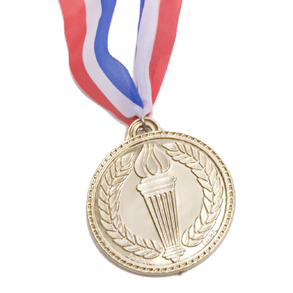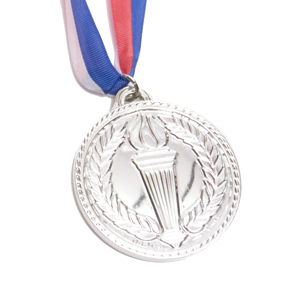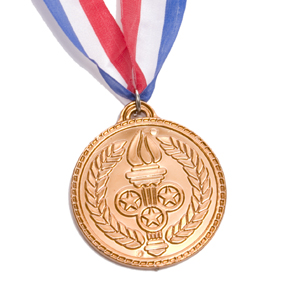|

NEMO, THE FIRST HERO Of His Kind... He was the first hero of his kind to return from the Vietnam War. The welcoming committee watched him walk down the ramp of the plane that had just landed at Kelly Air Force Base. He was wounded, his right eye was missing and a scar ran from below his right eye socket to his mouth. But his wounds weren't what made him different from other returning Vietnam veterans... it was because he was a dog.
Of the many dogs that served this country in Vietnam, Nemo is probably the most famous.
Nemo, was whelped October 1962, and was procured by the Air Force in the summer of '64, from a sergeant, for sentry dog training, when he was 1 1/2 years old.
After completing an eight-week training course at Lackland's Sentry Dog Training School, in San Antonio, Texas; the 85 pound, black and tan German Shepherd, and his new handler, Airman Bryant were assigned to Fairchild AB, Washington for duty with Strategic Air Command. In January 1966, Nemo and handler, Airman Leonard Bryant Jr., were transferred to the Republic of South Vietnam with a large group of other dog teams, and was assigned to the 377th Security Police Squadron, stationed at Tan Son Nhut Air Base.
Six month later, in July, Nemo's original handler rotated back to the States. The dog was then paired with 22 year old Airman 2nd Class Robert Thorneburg.
It's here that we begin our story, on how and why Nemo was to become famous... Nemo - No. A534, 377th Security Police K-9
Tan Son Nhut Air Base, Vietnam. Tan Son Nhut: The story took a tragic turn on December 4, 1966. During the early morning hours a group of 60 Viet Cong emerged from the jungle. Several sentry dog teams stationed on preventive perimeter posts gave the initial alert and warning almost simultaneously.
Immediately, Rebel, a sentry dog on patrol, was released. The response was a hail of bullets that killed the dog.
Forty-five minutes later the group was detected by sentry dog Cubby. Cubby was released with the same results. It was clear that the VC had learned to handle the attack dog.
Another dog, Toby, was killed and several handlers wounded before the attackers were finally driven off. As a result of this early warning, security forces of the 377th Air Police Squadron successfully repelled the attack, minimizing damage to aircraft and facilities. Although wounded, one dog handler maintained contact with the enemy and notified Central Security Control of their location and direction of travel.
Two security policemen in a machine gun bunker were ready and waiting as the Viet Cong approached the main aircraft parking ramp. In a few seconds they stopped the enemy, killing all 13 of the attackers.
Security forces rapidly deployed around the perimeter and prevented the infiltrators from escaping, forcing them to hide. Three airmen and their dogs had died in the fighting. By day break, the search patrols believed that all of the remaining Viet Cong were killed or captured. Unfortunately supervisors did not include dog teams in those daylight patrols.
Airman 2nd Class Bob Thorneburg and his dog Nemo were to become legends later that night.
The sentry dog teams that climbed into the back of the army truck that night were quieter than usual. Many of the handlers were thinking about the events of the previous night. They were saddened by the loss of their fellow K-9s. They were also anxious about what awaited them on their patrols. There was a good chance that stragglers from the previous night's attack could still be out there. That night, Thorneburg and Nemo were assigned duty near an old Vietnamese graveyard about a quarter mile from the air base's runways. No sooner had they started their patrol... Nemo alerted on something in the cemetery. But before Thorneburg could radio the CSC, that "something" opened fire. Thorneburg released his dog and then charged firing into the enemy. Nemo was shot and wounded, the bullet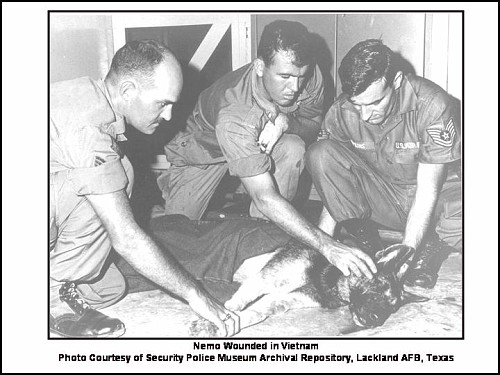 entering under his right eye and exited through his mouth. Thorneburg killed one VC before he too was shot in the shoulder and knocked to the ground. entering under his right eye and exited through his mouth. Thorneburg killed one VC before he too was shot in the shoulder and knocked to the ground.
That might of been the sad end of the story. But Nemo refused to give in without a fight. Ignoring his serious head wound, the 85 pound dog threw himself at the Vietcong guerrillas who had opened fire. Nemo's ferocious attack brought Thorneburg the time he needed to call in backup forces.
A Quick Reaction Team arrived and swept the area but found no other Viet Cong. However, security forces, using additional sentry dog teams, located and killed four more Viet Cong. A second sweep with the dog teams resulted in discovery of four more Viet Cong who were hiding underground. They, too, were killed.
Although severely wounded, Nemo crawled to his master and covered him with his body. Even after help arrived Nemo would not allow anyone to touch Thorneburg. Finally  separated, both were taken back to the base for medical attention. Thorneburg was wounded a second time on the return to the base. separated, both were taken back to the base for medical attention. Thorneburg was wounded a second time on the return to the base.
Lt. Raymond T. Hutson, the base vet, worked diligently to save Nemo's life. It required many skin grafts to restore the animal's appearance. Nemo was blinded in one eye. After the veterinarian felt Nemo was well enough, the dog was put back on perimeter duty. But it turned out his wounds needed further treatment.
On June 23, 1967, Air Force Headquarters directed that Nemo be returned to the United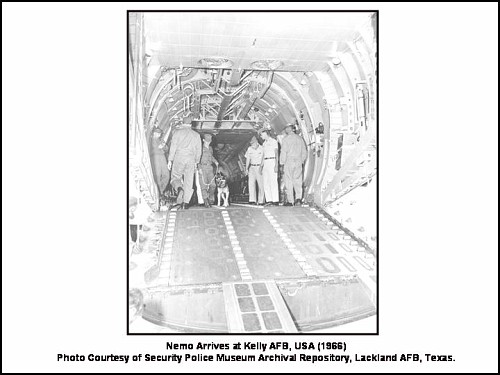 States with honors, as the first sentry dog to be officially retired from active service. States with honors, as the first sentry dog to be officially retired from active service.
Thorneburg had to be evacuated to the hospital at Tachikawa Air Base in Japan to recuperate. The handler and the dog who saved his life said their final goodbyes. Airman Thorneburg fully recovered from his wounds and also returned home with honors. Nemo flew halfway around the world accompanied by returning airman Melvin W. Bryant. The plane touched down in Japan, Hawaii and California. At each stop, Air Force vets would examine the brave dog for signs of discomfort, stress and fatigue...after all he was a 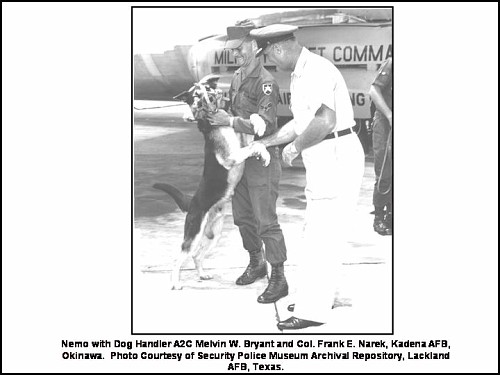 War Hero! War Hero!
Finally, the C-124 Globemaster touched down at Kelly Air Force Base, Texas, on July 22, 1967. Captain Robert M. Sullivan, was the officer in charge of the sentry dog training program at Lackland, and was the head of Nemo's welcome home committee.
"I have to keep from getting involved with individual dogs in this program," Sullivan said, "but I can't help feeling a little emotional about this dog. He shows how valuable a dog is to his handler in staying alive." After settling in Nemo and Captain Sullivan made a number of cross country tours and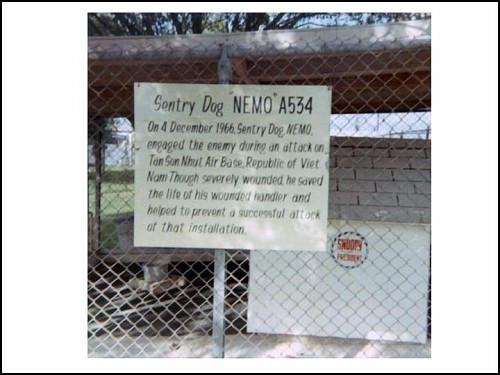 television appearances, as part of the Air Force's recruitment drive for more war dog candidates, until the US involvement in Vietnam started to wind down. television appearances, as part of the Air Force's recruitment drive for more war dog candidates, until the US involvement in Vietnam started to wind down.
Nemo then spent the rest of his retirement at the Department of Defense Dog Center, Lackland AFB, Texas. He was given a permanent kennel near the veterinary facility. A sign with his name, serial 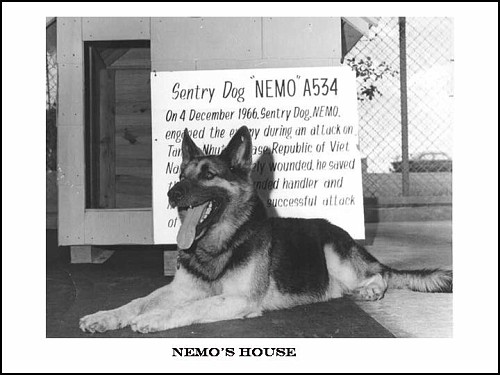 number, and details of his Vietnam heroic exploit designated his freshly painted home. number, and details of his Vietnam heroic exploit designated his freshly painted home.
Nemo died December 1972 at Lackland AFB, shortly before the Christmas holiday; after a failed attempt to preserve his remains, the Vietnam War hero was lain to rest on March 15, 1973, at the DoD Dog Center, at the age of 11. Until then, his presence at Lackland reminded students just how important a dog is to his handler - and to the entire unit. |
